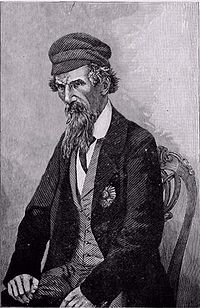
Lieutenant-General Sir Harry Burnett "Joe" Lumsden was a British military officer active in the British Raj.

Brigadier-General Sir Henry Montgomery Lawrence,, was a British military officer, surveyor, administrator and statesman in British India. He is best known for leading a group of administrators in the Punjab affectionately known as Henry Lawrence's "Young Men", as the founder of the Lawrence Military Asylums and for his death at the Siege of Lucknow during the Indian Rebellion.

Major-General Sir Herbert Benjamin EdwardesDCL was a British administrator, soldier, and statesman active in the Punjab region of British India. He is best known as the "Hero of Multan" for his pivotal role in securing British victory in the Second Anglo-Sikh War.

The Lahore Fort is a citadel in the city of Lahore in Punjab, Pakistan. The fortress is located at the northern end of Walled city of Lahore and spreads over an area greater than 20 hectares. It contains 21 notable monuments, some of which date to the era of Emperor Akbar. The Lahore Fort is notable for having been almost entirely rebuilt in the 17th century, when the Mughal Empire was at the height of its splendor and opulence.
The Treaty of Amritsar, executed by the British East India Company and Raja Gulab Singh of Jammu after the First Anglo-Sikh War, established the princely state of Jammu and Kashmir under the suzerainty of the British Indian Empire.

John Laird Mair Lawrence, 1st Baron Lawrence,, known as Sir John Lawrence, Bt., between 1858 and 1869, was a prominent British Imperial statesman and served as the Viceroy of India from 1864 to 1869.

The first Anglo-Sikh war was fought between the Sikh Empire and the British East India Company in 1845 and 1846 around the Ferozepur district of Punjab. It resulted in defeat and partial subjugation of the Sikh empire and cession of Jammu & Kashmir as a separate princely state under British suzerainty.
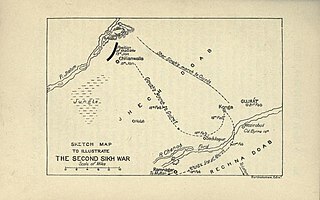
The second Anglo-Sikh war was a military conflict between the Sikh Empire and the East India Company which took place from 1848 to 1849. It resulted in the fall of the Sikh Empire, and the annexation of the Punjab and what subsequently became the North-West Frontier Province, by the East India Company.

The North-West Frontier was a region of the British Indian Empire. It remains the western frontier of present-day Pakistan, extending from the Pamir Knot in the north to the Koh-i-Malik Siah in the west, and separating the modern Pakistani frontier regions of North-West Frontier Province, Federally Administered Tribal Areas and Balochistan from neighbouring Afghanistan in the west. The borderline between is officially known as the Durand Line and divides Pashtun inhabitants of these provinces from Pashtuns in eastern Afghanistan.

Brigadier General John Nicholson, was an Anglo-Irish officer in the British Army who rose to prominence during his career in British India. Born in Ireland, Nicholson moved to the Indian subcontinent at a young age and obtained a commission in the East India Company where he spent the majority of his life helping to expand Company rule in numerous conflicts such as the First Anglo-Afghan War and the First and Second Anglo-Sikh War. Nicholson created a legend for himself as a political officer under Henry Lawrence in the frontier provinces of British India, especially in the Punjab, and he was instrumental in the establishment of the North-West Frontier. Nicholson's most defining moment in his military career was his crucial role in suppressing the Indian Rebellion of 1857, a conflict in which he died.

The Sikh Empire was a regional power based in the Punjab region of the Indian subcontinent. It existed from 1799, when Maharaja Ranjit Singh captured Lahore, to 1849, when it was defeated and conquered by the British East India Company in the Second Anglo-Sikh War. It was forged on the foundations of the Khalsa from a collection of autonomous misls. At its peak in the 19th century, the empire extended from Gilgit and Tibet in the north to the deserts of Sindh in the south and from the Khyber Pass in the west to the Sutlej in the east as far as Oudh. It was divided into four provinces: Lahore, which became the Sikh capital; Multan; Peshawar; and Kashmir from 1799 to 1849. Religiously diverse, with an estimated population of 4.5 million in 1831, it was the last major region of the Indian subcontinent to be annexed by the British Empire.

The Battle of Sobraon was fought on 10 February 1846, between the forces of the East India Company and the Sikh Khalsa Army, the army of the Sikh Empire of the Punjab. The Sikhs were completely defeated, making this the decisive battle of the First Anglo-Sikh War.
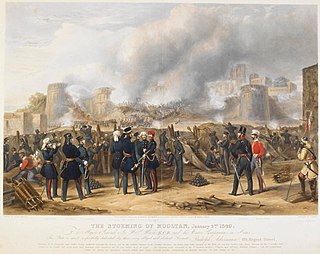
The siege of Multan began on 19 April 1848 and lasted until 22 January 1849, and saw fighting around Multan between the British East India Company and the Sikh Empire. It began with a rebellion against a ruler imposed by the East India Company, which precipitated the Second Anglo-Sikh War, and ended when the last defenders of the city surrendered to British forces.
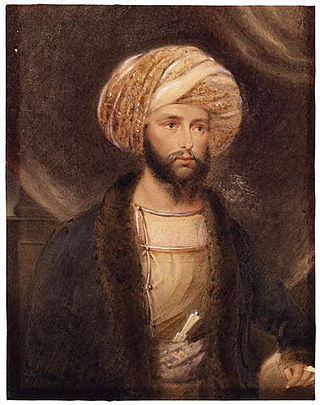
General Sir James Abbott, was an English military officer in the Bengal Army and an administrator in British India. The city of Abbottabad, in present day Pakistan, was founded by and named after him.

Mulraj Chopra was the Diwan (governor) of Multan and leader of a Sikh rebellion against the British which led to the Second Anglo-Sikh War.
The Treaty of Lahore of 9 March 1846 was a peace-treaty marking the end of the First Anglo-Sikh War. The treaty was concluded, for the British, by the Governor-General Sir Henry Hardinge and two officers of the East India Company and, for the Sikhs, by the seven-year-old Maharaja Duleep Singh and seven members of Hazara, the territory to the south of the river Sutlej and the forts and territory in the Jalandhar Doab between the rivers Sutlej and Beas. In addition, controls were placed on the size of the Lahore army and thirty-six field guns were confiscated. The control of the rivers Sutlej and Beas and part of the Indus passed to the British, with the Provision that this was not to interfere with the passage of passenger boats owned by the Lahore Government. Also, provision was made for the separate sale of all the hilly regions between River Beas and Indus, including Kashmir, by the East India Company at a later date to Gulab Singh, the Raja of Jammu.
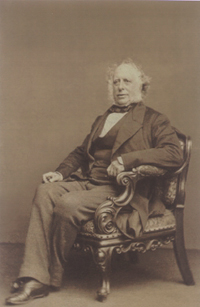
Sir Frederick Currie, 1st Baronet was a British diplomat, who had a distinguished career in the British East India Company and the Indian Civil Service. His posts included Foreign Secretary to the Government of India, Member of the Supreme Council of India, Resident at Lahore and Chairman of the East India Company.
Attock Khurd is a small town located beside the Indus River in the Attock District of Punjab Province in Pakistan. Khurd and Kalan are Persian words, themselves derived from Sanskrit words, which means small and big, respectively. When two villages have the same name in the same vicinity, they are often distinguished by adding Kalan and Khurd with the villages' names.

Major-General Reynell George Taylor was a British military officer who served in the Bengal Army.
Lieutenant colonel Frederick MackesonCB was an East India Company officer operating in the North West Frontier of British India and one of Henry Lawrence's "Young Men".
